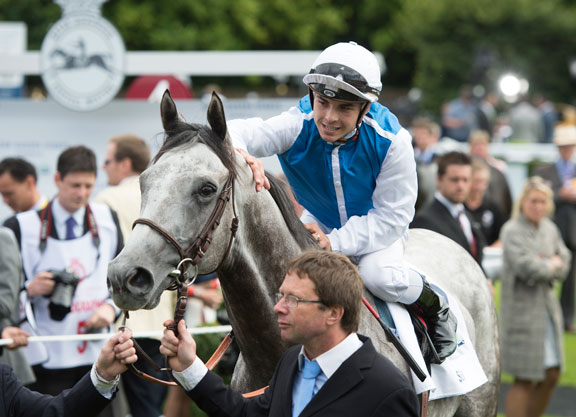By Andrew Caulfield
One of the contradictions of horse racing is that, although there needs to be a degree of certainty, simply to keep the betting public happy, it is often the sport's sheer unpredictability which makes it so fascinating.
Both facets were in evidence at a very enjoyable Qipco British Champions Day three days ago. With the ground riding a little faster than in previous years, there were fewer surprises than usual. Three of the four Group 1 contests fell to horses which had jointly accumulated eight previous Group 1 successes in 2015. Even so, two of these three winners–the Queen Elizabeth II S. winner Solow and the Fillies & Mares winner Simple Verse–highlighted the complexity of the breeding game.
Solow's story is familiar enough to require just the bare facts here. It was at the end of August last year that the then-4-year-old Solow ran away with the G3 Prix Quincey over a mile. Yet this son of the international star Singspiel had ended his 3-year-old campaign with a victory over a mile and a half at Longchamp. After extending his winning sequence to three when he reappeared as a gelding at four, Solow was asked to tackle a distance of nearly two miles in the G2 Prix Vicomtesse Vigier. Although he could finish no closer than sixth, he was beaten only around four lengths. Yet it was little more than three months later that he became a group winner over approximately half the distance.
Since then he has raced only between a mile and an extended mile and an eighth and the results have been nothing short of spectacular. His winning sequence now extends to nine, the last five wins coming at Group 1 level.
I must admit that I don't consider genetic testing necessary to decide the optimum distance for the vast majority of racehorses. With input from the riders and trainers, plus knowledge of the bloodlines, it isn't normally all that difficult to establish. Of course a headstrong temperament can ruin all the theory, but the bottom line is that running a horse over a certain distance is the only way to establish whether it is definitely within its compass.
For example this year's outstanding six-furlong horse Muhaarar, who was so impressive in the Qipco Sprint S., started his 3-year-old season with a record-setting victory in the seven-furlong Greenham S. This race acts as one of the main trials for the 2,000 Guineas over a mile and, when I assessed his pedigree in the TDN, I commented that:
“Trying to decide whether Muhaarar will be as effective over a mile as he is over seven furlongs is a fairly pointless exercise: we will only find out when he tackles that extra furlong. It has to be in his favour that he finished well in a strongly run Greenham, and that Oasis Dream has sired 2,000 Guineas winners in Ireland and Germany (2).”
His connections opted for the French version of the 2,000 Guineas, in the belief that it would represent less of a test of stamina. The result was inconclusive, as Muhaarar was drawn 18 of 18, on the wide outside, and never landed a blow, simply running on into eighth place. The fact that he pulled hard in the early stages no doubt influenced his connections' decision to return him to sprinting, in much the same way that his grandsire Green Desert had done after contesting the 2,000 Guineas in England and Ireland.
Muhaarar's trainer Charlie Hills clearly got it right, just as his father, the astute Barry Hills, had done so many times over the years. The example that sticks in my mind concerned a colt called Lord Helpus. When it came to predicting his optimum trip, Timeform limited its comment to a simple “stays 6f” after the colt had shown useful form in winning over five and six furlongs at two.
There was really no reason for thinking that the colt would stay any further. His sire, Green God, had won two of Britain's best sprints, the Nunthorpe and the Sprint Cup at Haydock, and Lord Helpus's first two dams were by Golden Cloud and Vilmorin. The average winning distances for these stallions' progeny were amongst the lowest in Britain and Ireland, at 6.70 and 6.32 furlongs, respectively. Even so, Hills Senior decided that a mile would suit the 3-year-old Lord Helpus and this was justified by two wins and an improved Timeform rating of 111. Then Hills ventured into uncharted territory with the 4-year-old Lord Helpus. The colt proved so versatile that he won the G3 Princess of Wales's S. over a mile and a half. The explanation is that, although three of his four grandparents were sprinters, the fourth–Green God's Italian-raced dam Thetis II–had won at up to a mile and a half.
To get back to Solow, his sire Singspiel was fast enough to win a maiden race over seven furlongs as a 2-year-old, but as a mature horse he shone over a mile and a quarter and a mile and a half (in Europe these are described as “middle distances” but I hesitate to use this phrase with readers in America, where the recent Best of Ohio Endurance S. was over a mile and a quarter and the Ladies Marathon was over 1 9/16 miles).
As a stallion, Singspiel built an average winning distance of 10.4 furlongs for his progeny, but there were some notable exceptions to this middle-distance profile. At one end of the distance scale, his son Take Cover won the G2 King George S. over five furlongs. At the other, his daughter Pale Mimosa won the G2 Lonsdale Cup over two miles and his son Papineau took the G1 Gold Cup over two and a half miles.
Solow's connections could be forgiven for expecting him to slot into the higher end of this distance range. His dam, the group-placed High Maintenance, had put up several of her best efforts at around 1 7/8 miles and she is a daughter of Fabulous Hostess, winner of the G2 Prix de Royallieu over an extended mile and a half.
So where does Solow's speed come from? The most likely source is his broodmare sire Highest Honor. A son of the top French miler Kenmare, Highest Honor was burdened with a June 15 birthday. He still managed to win over a mile at two and to finish second in the French 2,000 Guineas. With his birthdate no longer a handicap at four, Highest Honor became a Group 1 winner in the Prix d'Ispahan over 9.2 furlongs and later finished a good second in the G1 Prix de la Foret over seven. The d'Ispahan also ranks among Solow's Group 1 successes.
Moving on to the Fillies & Mare winner Simple Verse, the surprising aspect of her story concerns her sire Duke of Marmalade. Remarkably Simple Verse became the third Group 1 Classic winner of the year for her sire when her demotion in the St Leger was reversed. Duke of Marmalade, of course, had been banished to South Africa in apparent disgrace in May 2014 (see my article on Star of Seville on June 16 for the details).
Another of his daughters, Star of Seville, had started the sequence in the Prix de Diane, with Nutan following up with his win in the Deutsches Derby. Duke of Marmalade also sired Sound of Freedom, winner of Italy's G3 1,000 Guineas equivalent, and his other notable 2015 representatives include the dual Group 2 winner Big Orange.
Simple Verse came on the market as a yearling at Goffs' Orby Sale, just months after her out-of-favor sire had covered a book of only 30 mares. It is therefore a measure of her imposing physique and quality bloodlines that she cost €240,000.
Her dam Guantanamera is one of 169 representatives of the remarkable Sadler's Wells-Darshaan nick. No fewer than 28 of these 169 became black-type winners (17%), but the really impressive statistic concerns the eight Group 1 winners, which equated to 4.7%.
Guantanamera didn't figure in these statistics, as she never raced, but she is now one of the broodmares successfully extending the nick's influence. Other Sadler's Wells mares with a dam by Darshaan have produced the Group 1 winners Taghrooda (Oaks and King George), Cursory Glance (Moyglare Stud S.) and Diamondsandrubies (2015 Pretty Polly S.).
A mile and a half appears to be a minimum trip for Simple Verse, which is hardly surprising when the Group 1 winners sired by Sadler's Wells from daughters of Darshaan included Milan (St Leger), Septimus (Irish St Leger) and Ebadiyla (Irish Oaks and Prix Royal-Oak).
Not a subscriber? Click here to sign up for the daily PDF or alerts.






